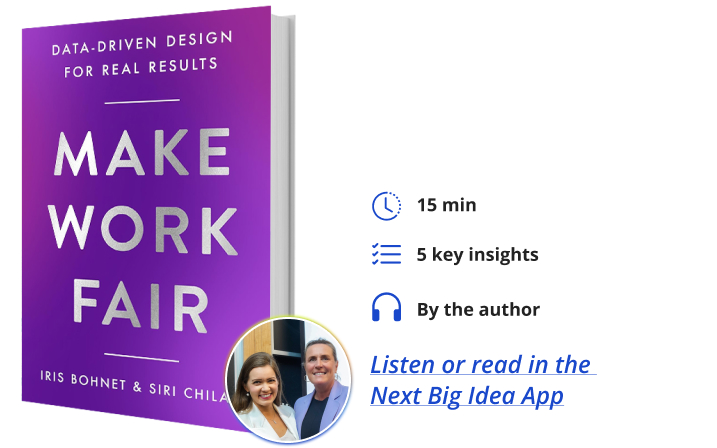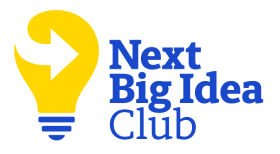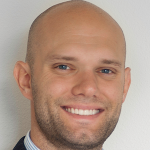Siri Chilazi is a senior researcher at the Women and Public Policy Program at Harvard Kennedy School. Iris Bohnet is a professor of business and government at Harvard Kennedy School and co-director of the Women and Public Policy Program.
What’s the big idea?
Fairness is not merely a choice; it is a way of moving through the world. For life and work to exhibit more fairness, people need to embed fair behavior into everyday choices, routines, and systems. Everyone can show up in ways that allow for a diversity of people to be seen, heard, and valued at the table.
Below, co-authors Siri and Iris share five key insights from their new book, Make Work Fair: Data-Driven Design for Real Results. Listen to the audio version—read by Siri and Iris—in the Next Big Idea App.

1. Fairness must be embedded in our systems.
At some hotels, room key cards both unlock doors and control the lights. This little bit of technology makes it more likely that the lights are off when leaving the room. This is our vision for fairness as well. We want to embed it into everything we do.
Fairness is not a program, it is a way of doing things, but it does not happen automatically. Only a few years ago, Swedish engineer Astrid Linder and her team developed the first crash test dummy built in the form of a woman’s body. And during COVID-19, personal protective equipment (PPE) was not made for everyone: not for those with small hands or large feet, and not for cultural dress codes that did not correspond with standard overalls. Unfairness can creep in anywhere: cars, protective gear, artificial intelligence, data for decision-making, and workplace procedures.
A few years ago, we were approached by one of the largest employers in Australia. People had applied to positions of leadership at this organization and they sent those who were not chosen an email inviting them to reapply. They found that men were about twice as likely to reapply than women. Why was this and what could they do to not lose that talent? We asked the organization, who exactly are you writing to? They responded that they only asked the top 20 percent of applicants to reapply. This was our opener.
Given that women have been found to be less self-confident, we suggested that we run a randomized control trial. Some applicants still got the email that was normally sent, but for others, we added one sentence sharing that they were among the top 20 percent of applicants. This edit completely closed the gender gap in reapplication rates. We fixed the system and equalized the playing field for all.
2. Make fairness count.
Ros Atkins, a TV presenter at the BBC, made fairness count when he realized he had no data to know if he featured women and men with equal frequency as experts on his nightly primetime news show. Atkins and his team decided to generate that data. They began spending two minutes at the end of each night’s show counting how many women and men had appeared on screen during their one hour on air. This counting exercise illuminated that women made up only 39 percent of experts on air—a much lower share than they had anticipated. They set themselves a target of reaching 50:50 gender representation and became more thoughtful about featuring a diversity of experts on air. Within four months, they hit their target and maintained it for years.
They also inspired hundreds of other BBC content-creating teams to join them in what has globally become 50:50 The Equality Project. Even though it wasn’t an organizational mandate, Ros Atkins and his team made fairness count in their work. They simply knew that for journalism to be of the highest quality, it needed to represent the world they reported on. They tweaked their everyday ways of working to better deliver on that goal.
“Even though it wasn’t an organizational mandate, Ros Atkins and his team made fairness count in their work.”
Another great example is Google, which discovered a few years ago that women were leaving the company at higher rates than men. A deeper dive into the data revealed that new mothers drove this pattern. Google tested a solution: increasing the length of leave available to all new parents from 12 to 18 weeks. Google continued to monitor the data and discovered that this solution worked to close the gender gap.
To make fairness count, we need to use the same tools we rely on to manage our daily work on incentives and accountability. Accountability, in particular, is critical because research shows that it’s one of the most powerful influences on behavior. For the 50:50 project, this meant that all participating teams could see each other’s data. When humans know that our actions are being watched, we’re more likely to be on our best behavior.
3. Make fairness stick.
For fairness to stick, we must build changes into existing practices and procedures.
Consider the resume: perhaps a benign document describing our educational and work experience, but whoever decided what a resume should look like? Two of our collaborators, Ariella Kristal and Oliver Hauser, took this to heart and tested the impact of a redesigned resume. They were interested in one specific issue: how we describe work experience.
They explored the impact that different ways of framing work experience on resumes have on the likelihood that an applicant will be invited to an interview. They responded to job postings by more than 9,000 employers in the United Kingdom and presented job history either by displaying a single number indicating how many years a job was held or (as it is commonly done) by indicating the dates during which the applicants worked in a given job.
The change in framing made the applicant’s acquired expertise salient while obfuscating employment gaps. When prior work experience was shown by the number of years worked, without any dates, it increased the likelihood that a candidate would be invited to an interview by 15 percent. This finding held for women and men. While this reframing is gender-neutral, it will disproportionately benefit those more likely to have had career breaks: women.
4. Make fairness normal.
Before the pandemic, flexible work was typically a special accommodation available only by request and not always granted. For decades, research has shown that providing flexible work options for everyone improves retention, employee satisfaction, and productivity. Studies in the U.K. and Switzerland even showed that job postings advertised as flexible received up to 30 percent more applications, especially from women. It took COVID-19 for most organizations to accept flexible work as a default option for all their workers.
“Closing perception gaps shifts what people view as normal and, therefore, what they end up doing.”
Employees and job seekers pay attention to company signals about their norms and culture. Drivers do the same. In Montana, 85 percent of drivers reported using seat belts, but they estimated that only 60 percent of other drivers would do so. In Saudi Arabia, married men similarly underestimated the share of other husbands who support their wives working outside the home. Eighty-seven percent of Saudi men said they were supportive, but they believed only 63 percent of their peers would be.
Closing perception gaps shifts what people view as normal and, therefore, what they end up doing. Like in meetings, if your workplace has a culture of rampant interruptions, it can be hard to get the full benefit of everyone’s ideas. One simple way to shift this norm is to interrupt the interrupter like this: I look forward to hearing what you have to say, but please let Nicole finish her point first. Soon, interruptions will likely become less common because they are no longer tolerated or viewed as normal.
5. Make fairness personal.
In the film Hidden Figures, Katherine Johnson, Mary Jackson, and Dorothy Vaughan were three brilliant mathematicians who worked for NASA during the space race in the 1960s. Jackson became the first female African American engineer at NASA, Vaughan was the space agency’s first African American supervisor, and Johnson conducted crucial research on flight trajectories for various space shuttle missions. Role models matter. Seeing is believing.
A few years ago, India amended its constitution with the provision that a third village head position had to be held by women. Seeing women in leadership changed what women in these villages thought was possible for themselves. They became politically active, spoke up in town hall meetings, and were likelier to run for political office. The role models inspired parents who reported that one of the core career aspirations for their daughters was to become a politician. You can be one of these role models. You can also change the portraits on your office walls to ensure they represent everyone. You can inspire others to dare.
The crux of making work fair is that it must be part of every single person’s job. No matter your role, seniority, or activities, there is something that you personally can do to make work more fair. We liken this to communications. Most companies have a dedicated corporate communications department that handles high-profile press releases and CEO speeches. But simultaneously, every employee writes emails, speaks in meetings, and creates slide decks daily.
Make small changes in the way you work and share them with others. Shift what people see as normal or what people expect as the way to do things. Together, we can get further faster and see real results unlike ever before.
To listen to the audio version read by co-authors Siri Chilazi and Iris Bohnet, download the Next Big Idea App today:





























